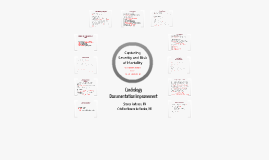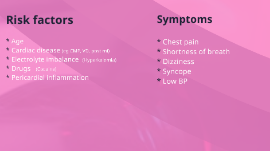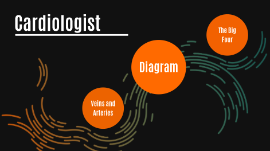Cardiology Presentation
Transcript: Severe COPD vs COPD exacerbation Acute respiratory insufficiency / distress Acute respiratory failure Chronic respiratory failure Acute on chronic respiratory failure COPD 93 yo female presented to HTH with chest pain and was transferred to SMH with a possible STEMI. DIAGNOSES #1 ACS with LV dysfunction of the anterior and apical wall #2 Acute moderate pulmonary edema After clarification: #1 Non-ST-segment elevation myocardial infarction #2 Congestive heart failure, resolved, secondary to atrial fibrillation and non-ST-segment elevation myocardial infarction “Acute systolic heart failure” Acute Coronary Syndrome FINAL PRIMARY DIAGNOSIS #1 Acute on chronic heart failure, diastolic, Left and Right sided. ADDITIONAL DIAGNOSES #1 Acute on chronic respiratory distress #2 Bilateral pulmonary edema #3 Hyperlipidemia #4 Hypertension #5 Acute renal failure, possibly acute on chronic Acute Renal Failure with Acute tubular necrosis #6 Controlled Diabetes Mellitus, Type 2 with peripheral neuropathy and retinopathy #7 Paroxysmal atrial fibrillation, no RVR, anticoagulated #8 Obesity, BMI 37 Summary Diagnoses #1 Paroxysmal atrial fibrillation with rapid ventricular response #2 Acute on chronic left ventricular diastolic heart failure secondary to cardiac amyloidosis #3 Cardiac amyloidosis #4 Chronic pericardial effusion #5 Cough #6 Right lower lobe pulmonary infiltrate We will continue a Levaquin antibiotic therapy initiated on January 7 for a total length of five days to cover possible community-acquired pneumonia. #7 Chronic kidney disease stage 3 #8 Gout Cardiology Documentation Improvement Chief Complaint Dyspnea, shortness of breath History of Present Illness Mrs. Doe is an 85 yo woman who has had significant SOB and hypoxemia for the past year. History of diastolic heart failure and chronic COPD. She is currently on 3 L oxygen all day due to hypoxemia. She was seen in heart failure clinic today and was admitted for IV diuresis. O2 sat at 86% on RA at rest. Fatigue with noticeable exacerbation from baseline dyspnea. BMI 47 kg/m2 Unstable Angina NSTEMI - date STEMI - name wall location & date Acute Coronary Syndrome CHRONIC OBSTRUCTIVE PULMONARY DISEASE (C O P D) Severity / Acuity Documentation Document all diagnosis to the highest specificity Document all medical conditions that are monitored, evaluated, or treated "Hypokalemia" "Hyponatremia" "Pancytopenia" Document the cause or probable cause of a symptom as specific as possible. "Acute blood loss anemia related to GI bleed" Document any diagnosis confirmed by lab tests, radiology exams, pathology reports. Use ACUTE instead of extreme or severe "Acute Endocarditis" "Acute Pulmonary Embolism" "Acute Myocardial Infarction, type, vessel, date of MI" FINAL PRIMARY DIAGNOSIS #1 Unstable angina due to ....... (link cause) ADDITIONAL DIAGNOSES #2 Coronary artery disease, LAD predominance #3 History of dilated cardiomyopathy, possibly secondary to chronic alcohol abuse "Alcoholic Cardiomyopathy" #4 Transfusion dependent iron deficiency anemia #5 Pancytopenia #6 Tobacco dependence #7 Medication noncompliance #8 Malnutrition, BMI 17.5 Acute / Chronic Respiratory Failure Summary Diagnoses Excellent Documentation FINAL PRIMARY DIAGNOSIS #1 Acute on chronic left diastolic heart failure ADDITIONAL DIAGNOSES #2 Acute on chronic respiratory failure #3 COPD exacerbation #4 Uncontrolled hypertension #5 Paroxysmal atrial fibrillation #6 Hypokalemia, chronic, likely due to Lasix use #7 Acute kidney injury, pre-renal due to diuresis #8 Diabetes Type 2, uncontrolled #9 Morbid Obesity, BMI 47 kg/m2 Final Take Away Message Avoid Documenting ACS when indicating MI Document severity of COPD Exacerbation Respiratory failure / Insufficiency Acute / Chronic Link symptoms to cause Capturing Severity and Risk of Mortality Acute Coronary Syndrome Clarification Summary Diagnoses Good Example Cardiology Admission Note IMPRESSION/REPORT/PLAN (resident) #1 Likely non-ST-segment elevation MI #2 Systolic heart failure, Ejection fraction of 17% Consultant’s note: ( x 3days) #1 Possible acute coronary syndrome with positive troponin At this point, we will treat her as an acute coronary syndrome and continue to follow her on monitor and with cardiac biomarkers. After clarification: #1 Non-ST-segment elevation myocardial infarction #2 Compensated biventricular systolic heart failure Ms. XXX ultimately ruled in for non-ST-segment elevation myocardial infarction Sharon Axtman, RN Cristina Rosero de Ruales, RN Acute Coronary Syndrome

















